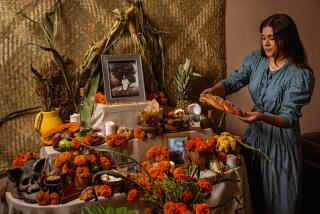Visiting the Cities of the Dead to Find a Mirror of Human Life
- Share via
NEW ORLEANS — On the feast days of All Saints and All Souls, Tuesday and Wednesday, people will come with flowers, ennobling concourses for the dead.
Cemeteries are cities of the dead, necropolises, designed and governed by a sense of order and continuity. That is what we owe the dead--dignified proof that each life merits the journey’s end, a place as permanent as stone.
From the sprawling cemeteries in large cities to the tiniest graveyards in remote country parishes, the solemnity of time cloaks those who gather to remember.
Is it only the humbling awareness of our own mortality that shrouds the living on such visits? I think not. As expressions of art, cemeteries exert a metaphysical pull. The tombs, sarcophagi, classical figurines and burial edifices convey hard, durable metaphors of past civilizations.
These sensations vary according to the images, the symbols and the aesthetic design of a given ground. In the South one finds soldier statues that often seem to outnumber the angels and cherubs. Head markers have myriad pictures--I know of one in a Cajun town with sadly down-sloping oak branches carved into the granite like a visual poem. Mausoleums have Greek columns planted in a grid-work of structures, some as elegant as expensive houses. All of this emulates life, reflecting the living as much as the dead.
Where else, save in churches and synagogues, do people behave better than they do in cemeteries? Maybe that is because the dead cannot answer, even though many of us sense they are watching, knowing more than we do.
I have always found it strange that some people cannot bear to spend time in cemeteries, and visit only with the duty of a funeral. Whatever one’s religious beliefs, this attitude registers an implicit fear of death and more--an uneasiness with the miniature metropolis, where the dead live through signs of art.
To me, cemeteries are serene places, inviting Wordsworth’s “Recollection of Emotion Amidst Tranquility.” I am thinking now of the Jesuit headstones, nestled in a grove below the Old North building of Georgetown University in Washington, a small, green space with the memory of priests who planted a human foundation in minds of the young, long before the campus building boom of the late 1970s.
To know a city is to know its cemeteries. In Paris, Pere-Lachaise, perhaps the most famous European cemetery, covers 116 hilly acres on the Right Bank. Greek figurines, vine-bedecked towers and ornate, rococo or neoclassical memorials line the walkways, where red and yellow leaves crunch underfoot on crisp autumn days. And what residents!--Balzac, Chopin, Moliere, Oscar Wilde, Colette.
In recent years, a Halloween ritual has drawn cultists to the grave of Jim Morrison, the musician who died of a drug overdose in Paris and is buried in Pere-Lachaise. There, among such illustrious dead, hard-rockers gather to memorialize the man of that ‘60s Doors anthem, “Light My Fire.” Oscar Wilde, if not Balzac, would applaud.
Across the city, the small cemetery of Montparnasse is the resting place of Jean-Paul Sartre. When I lived in Paris in the early ‘80s, I was struck by the stark simplicity of that headstone, just name and dates. Sartre was a confirmed atheist. What would he think of the people drawn to his grave? Are the books not enough? Why do they come and look?
Simple yearning has much to do with this search for something tangible, to connect the words and person of the artist. Michelangelo’s statue of David in Florence is Michelangelo to countless viewers.
Unlike the dead, whose chiseled names register the permanent authority of time, the artistry in cemeteries remains largely anonymous. Thousands of tourists flock to cemeteries in New Orleans, where soggy soil dictates above-ground burial, spawning rich castings of the imagination. Yet who among the visitors--or locals--can identify the tombstone-makers, the sculptors, the artisans who forged wrought-iron gates and fences?
Lately I have been drawn to a small one-block graveyard near my house in New Orleans. The view is almost surrealistic--across fanned rows of gray and white headstones toward a utility power station across the street, looming over this tiny necropolis like a gigantic work of science fiction: the old world in the ground, the space age in the sky.
For the dead, good Christians pray. And in the final measure, each cemetery becomes a mirror beckoning each of us to take time, step closer and look into ourselves.


